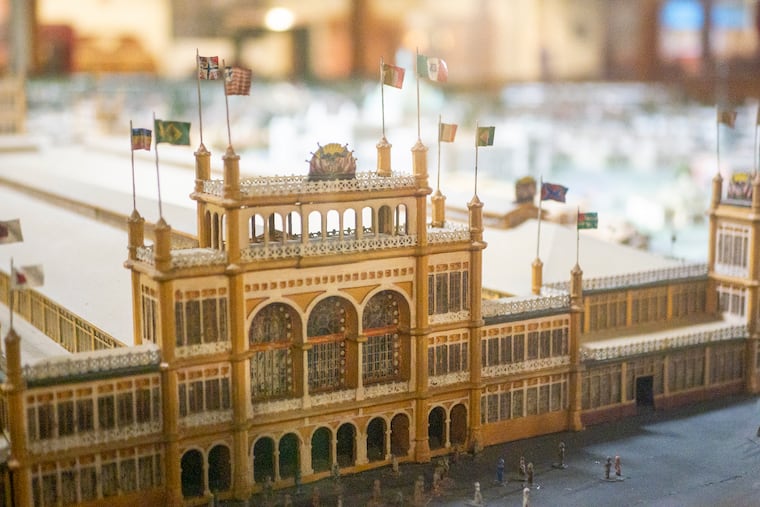New Please Touch gallery will head back to the Centennial of 1876 to help kids imagine the future
A $1.7 million renovation will spotlight the historic scale model of Philadelphia’s great 1876 Centennial Exposition — with 21st century digital interactives — as a way to foster invention and creativity in children.

Beneath the colorful entrance hall of the Please Touch Museum, below the fanciful rendering of the Statue of Liberty torch, deep in a basement gallery, beyond the shopping exhibit with kids pushing carts into one another, sits one of Philadelphia’s great historical artifacts.
The city-owned, 20-by-40-foot exact scale model of the 1876 Centennial Exposition has been in the Memorial Hall basement for more than a century, often forgotten. But when Please Touch took over the building more than a decade ago, leaders vowed to make the intricately detailed model a highlight of its own gallery.
It didn’t quite work out. Children found the poorly lit model hard to see, and it was presented in a passive fashion. And so it sat.
But now the museum is set to try again in the belief that a reconstructed and reimagined gallery can convey the creative spirit embodied in the world’s fair that unfolded right outside the museum’s front door in Fairmount Park 143 years ago.
“Imagine when people walked into the fair in 1876,” said Charles McGhee Hassrick, the museum’s director of exhibitions. “They were walking into the future, whether it was seeing the Corliss engine [that powered the entire exposition] or it was tasting root beer or eating popcorn for the first time.
“The typewriter, the telephone — these incredible things were being shown at the fair. The spirit of innovation was truly magnificent,” McGhee Hassrick said. "And that’s the kind of thing we want to do here.”
Think big! This will be a gallery that embraces Philadelphia, beachhead of the banana and the band-aid and the telephone — and a host of other innovations traceable to the Centennial of 1876.
New for the 21st century will be digital drone fly-overs filmed from within the scale model and digital walk-throughs of the great fair. Sidle up and try your hand at a SimCity-like game — based in Parkside.
Patricia D. Wellenbach, president and chief executive of the museum, said, “We believe this gallery will transform the lower level of this museum.”
Construction of a wall-to-wall, floor-to-ceiling, $1.7 million redo began Tuesday, and when it is completed toward the end of March, the 5,000-square-foot gallery will present the historic Centennial model as an imaginative focal point for a gallery that seeks to inspire creativity.
The model’s old gallery never did that.
“It didn’t encourage children to think big, think about problems, how to change the world,” said Wellenbach.
Now the gallery will ask: “If you could change the world, what would you invent, create, design?” she said. “Who would you become — a teacher, an artist, a scientist, an astronaut, a painter, an activist? And then, what would the world look like? Once you’ve created your concept, how would that change the world and how would the world change?
“In less than six months, this entire gallery will be totally reconstructed to engage children and visitors with those core questions,” she said. Only the gallery will close for renovations; the rest of the museum will be open.
The funds are entirely in hand, said Wellenbach, and the project is on time. It is the first gallery reconstruction since Please Touch emerged from bankruptcy in 2016.
At the center of the gallery will be the Centennial scale model, created by dozens of artisans in 1889 to capture not just the exposition in general, but how it looked — exactly — on a particular day, July 4, 1876.
How to convey that in 2019 and beyond? Video and still cameras were attached to a boom and then inserted into the model’s airspace. They passed back and forth over the buildings and the miniature landscape of the park, documenting ground-level and bird’s-eye views.
“There’s incredible detail," McGhee Hassrick said. “But no one but the artist or the artisan who made it could see the detail. The digital photography allows us to actually get into the model and allows people to actually experience it right up, as if you were a pedestrian.”
This will be achieved, at least in part, by digital screens that kids and their minders can manipulate to zoom in wherever they want. There’s a lot to see — the Centennial sprawled over 450 acres. It featured about 200 buildings (Memorial Hall and Ohio House on Belmont Avenue are the only survivors), including a hospital and a post office, plus a monorail.
Beyond the whiz-bang use of the model, the new gallery will feature something dubbed “Designer Community,” a digital interactive that Wellenbach called “SimCity for Fairmount Park.” This exhibit, which uses structures and landmarks from the Parkside neighborhood, seeks to show children how they can develop “the ability to make a future and change their community,” she said.
“We’re very focused on programming that’s socially responsible,” said Wellenbach, noting that racism, for instance, was a defining experience of the Centennial. Programming around the gallery will reflect that, she said.
Other features of the gallery will include the conception, building, and drawing of inventions; a stage for presentations; a scavenger hunt for objects and ideas; and an exhibit built around prominent leaders, present and past.
The gallery is designed to engage children from 3 to 10 years old, and up to fourth grade.
“The base of all this,” said McGhee Hassrick. “is to explore why we want to innovate.”